


By Kranti Sala, WELL AP, LEED Green Associate
A well-designed lighting strategy in spaces that support the life sciences, including labs, R&D facilities, and offices, can harmoniously support the occupants’ needs while enhancing the architectural design. Lab spaces are constantly evolving and increasing at an astounding rate, particular in the Boston/Cambridge and surrounding areas. Boston has become the national capital of the life sciences industry forecasting nearly 10 million square feet of office and industrial space in Greater Boston being converted into labs and the addition of 40,000 jobs through 2024. This growing industry has attracted more than $7 billion into the local economy and included nearly 5.8 million square feet of construction in 2020-21.
Many of these lab spaces are trending from traditional design models to flexible and collaborative environments. These modern labs are in high demand at both academic institutions and corporate facilities and spearhead a variety of experiments comfortably and efficiently. Often, these projects must meet elevated sustainability goals because of their high energy consumption and be accommodating to their occupants. Lighting designers need to focus on how to support flexible lab configurations and be mindful of how the spaces are going to be used. The lighting design approach for these spaces requires a certain perspective and knowledge base to address these multi-layered challenges holistically.
 To assure that all luminaries in lab spaces are properly specified and meet environmental requirements, the designer must pay attention to the luminaire rating systems and finish of the products. Depending on the activities conducted in the space, it is the lighting designer’s job to make these recommendations. IP (Ingress Protection) Rating and ISO (International Organization for Standardization) Class, which measures the clean room level of cleanliness are the most important rating systems considered for lab spaces. Antimicrobial finish is also often considered for luminaries.
To assure that all luminaries in lab spaces are properly specified and meet environmental requirements, the designer must pay attention to the luminaire rating systems and finish of the products. Depending on the activities conducted in the space, it is the lighting designer’s job to make these recommendations. IP (Ingress Protection) Rating and ISO (International Organization for Standardization) Class, which measures the clean room level of cleanliness are the most important rating systems considered for lab spaces. Antimicrobial finish is also often considered for luminaries.
Since some labs work with gases and chemicals, it is safe to specify vapor tight fixtures to protect electrical parts and the light source inside ensuring the luminaire can operate properly. IP65 can be referenced as a recommended rating system but may vary based on the type of lab. A minimum of ISO8 is required when clean-room conditions are necessary. Different types of lab rooms will require different rating systems, but the lab needs to meet either IS08 OR IP65 or in some cases, both. An antimicrobial white finish is recommended to limit the spread of bacteria and safety of the product.
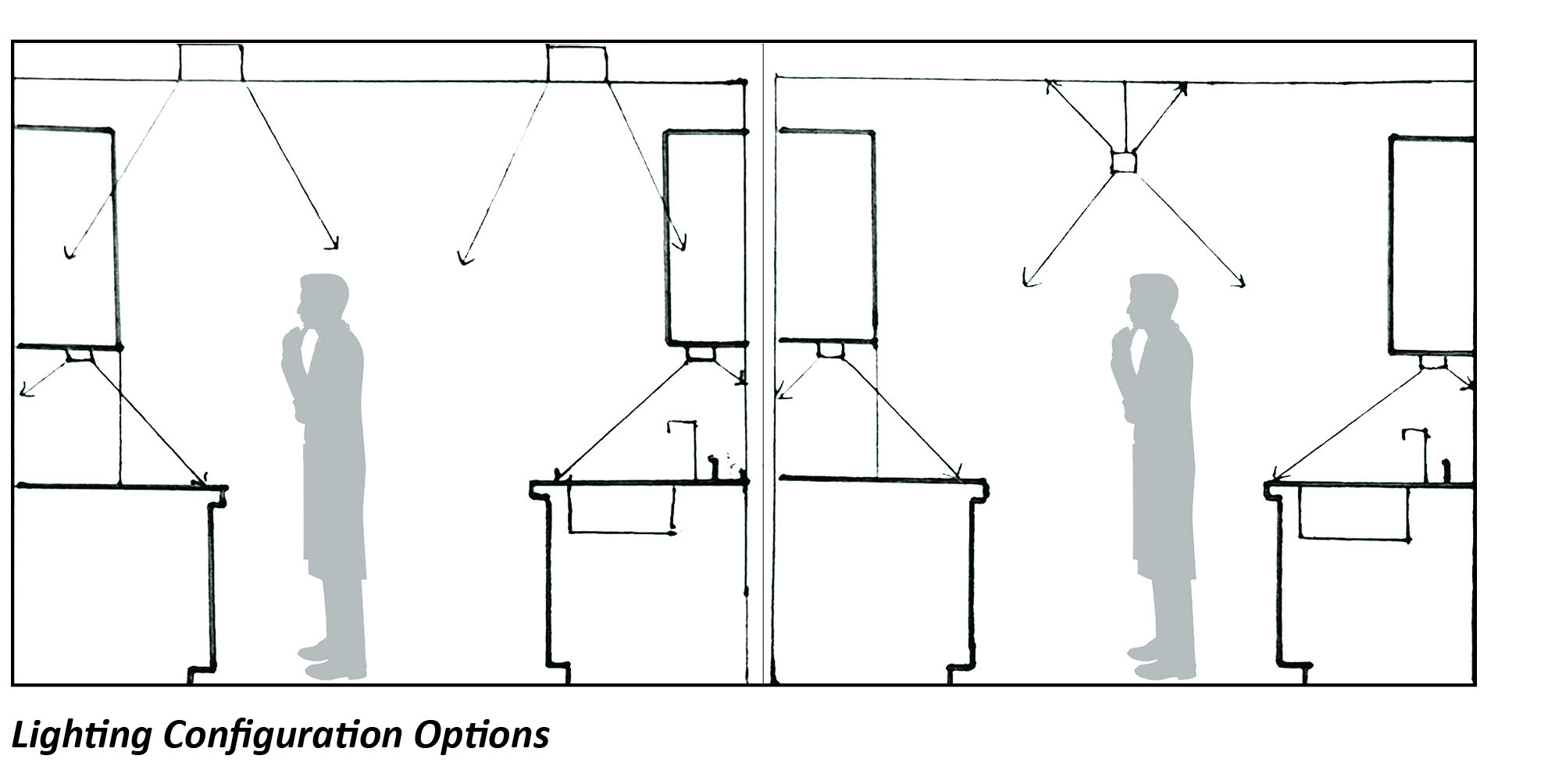 While there is no single best lighting scheme for a lab, it is very important to carefully pick the appropriate fixture configuration and location to avoid shadows at the work-surfaces and provide ample illumination for visibility to perform tasks. The lighting scheme will also have a significant impact on the space’s energy use.
While there is no single best lighting scheme for a lab, it is very important to carefully pick the appropriate fixture configuration and location to avoid shadows at the work-surfaces and provide ample illumination for visibility to perform tasks. The lighting scheme will also have a significant impact on the space’s energy use.
DIRECT-INDIRECT & DIRECT ONLY LIGHTING
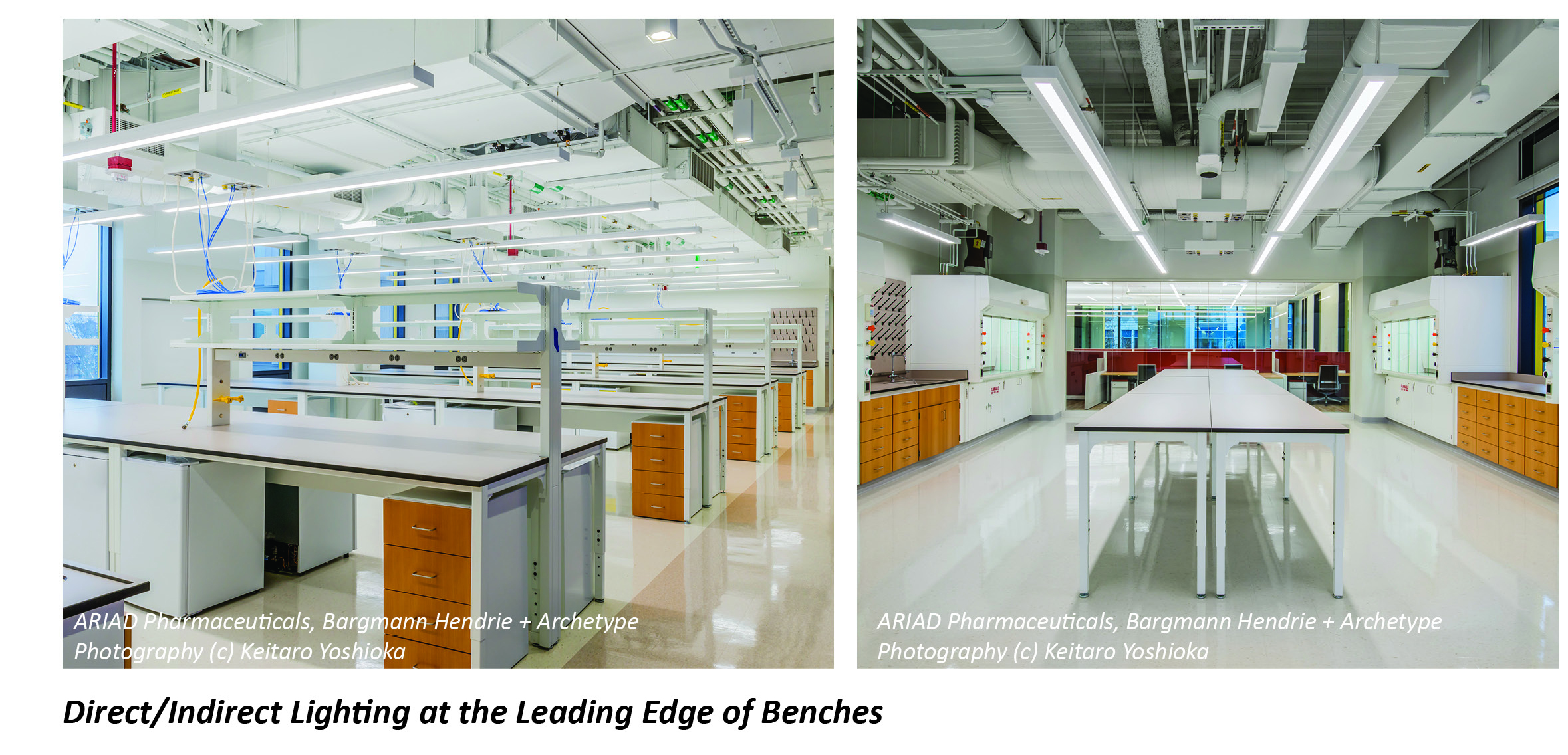
Based on experience, I often find direct/indirect ambient lighting as the preferred option for lab spaces. The preferred mounting of fixtures is to mount parallel to the benches, either placing it at the leading edge of the bench or between benches.
This lighting scheme can provide high illumination levels at the bench-top/work-surface while minimizing glare and high contrast light levels on interior surfaces. This will mitigate unwanted shadows and provide adequate illumination to perform research, tests, and/or experiments. The best practice is to maintain 18” to 24” spacing between the fixture and ceiling and to use high Light Reflectance Value (LRV) for ceiling finishes.
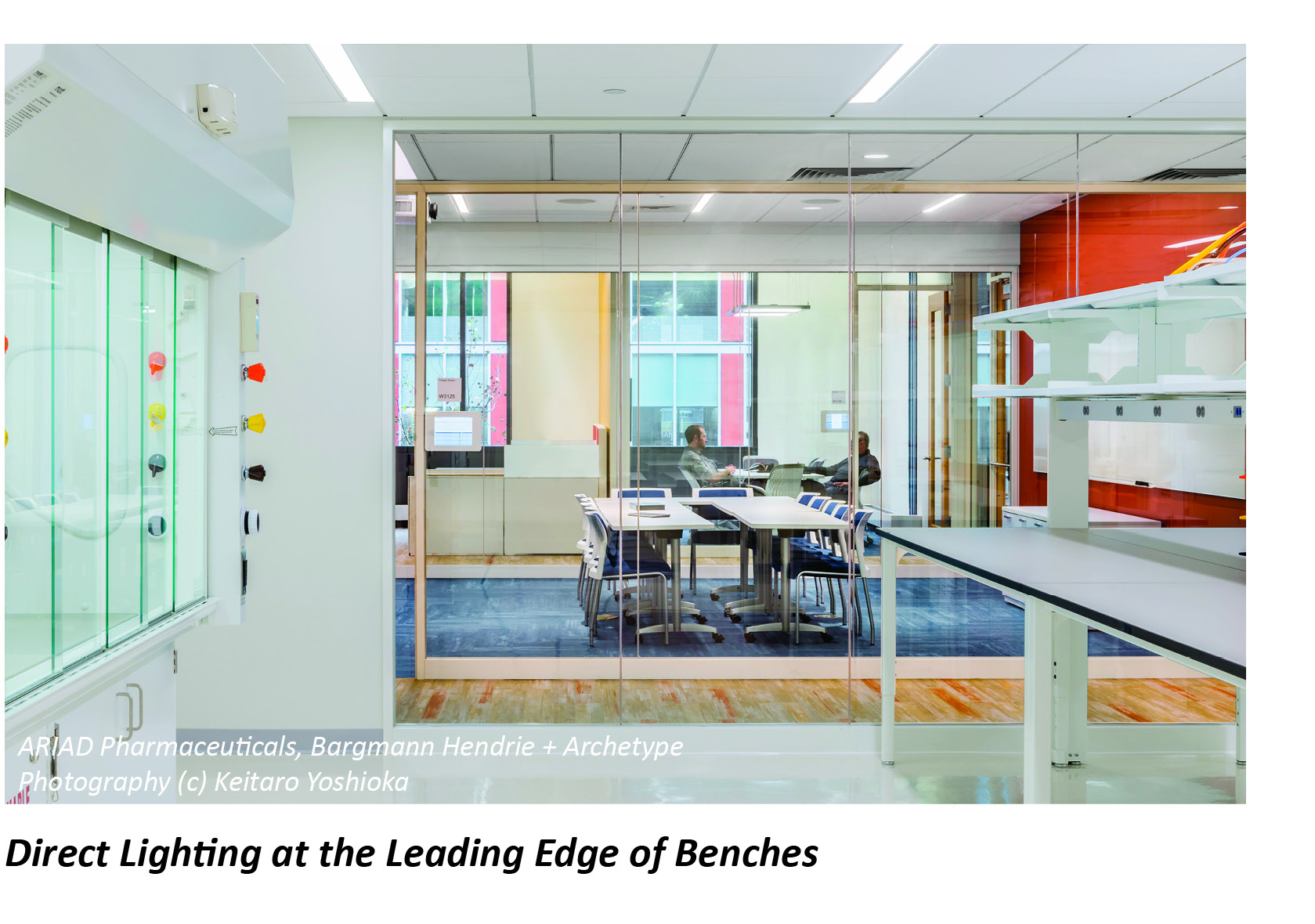 On the other hand, direct linear lighting is suitable for low ceiling spaces as it directs all the light towards the work-surface to meet the required illumination levels. This approach aims to reduce Light Power Density. Since labs require high light levels, the width of the fixture aperture is also an important consideration. Wider aperture light fixtures are recommended for visual comfort over a narrower lens to avoid glare.
On the other hand, direct linear lighting is suitable for low ceiling spaces as it directs all the light towards the work-surface to meet the required illumination levels. This approach aims to reduce Light Power Density. Since labs require high light levels, the width of the fixture aperture is also an important consideration. Wider aperture light fixtures are recommended for visual comfort over a narrower lens to avoid glare.
TASK LIGHTING
Task lighting is an important consideration for these spaces as the work is often conducted at eye level and the requirements vary depending on the type of task being carried out. Since the bench-top/work-surface is three-dimensional, a shelving unit will block some overhead light from the luminaire, preventing it from reaching work surfaces. Movable benches are commonly found in these spaces to give researchers flexibility. It is recommended to design the space with task lights that are mounted directly to the benches. However, adjustable shelving and movable benches are part of the design challenge for built-in task lighting. Proper coordination and planning are critical.
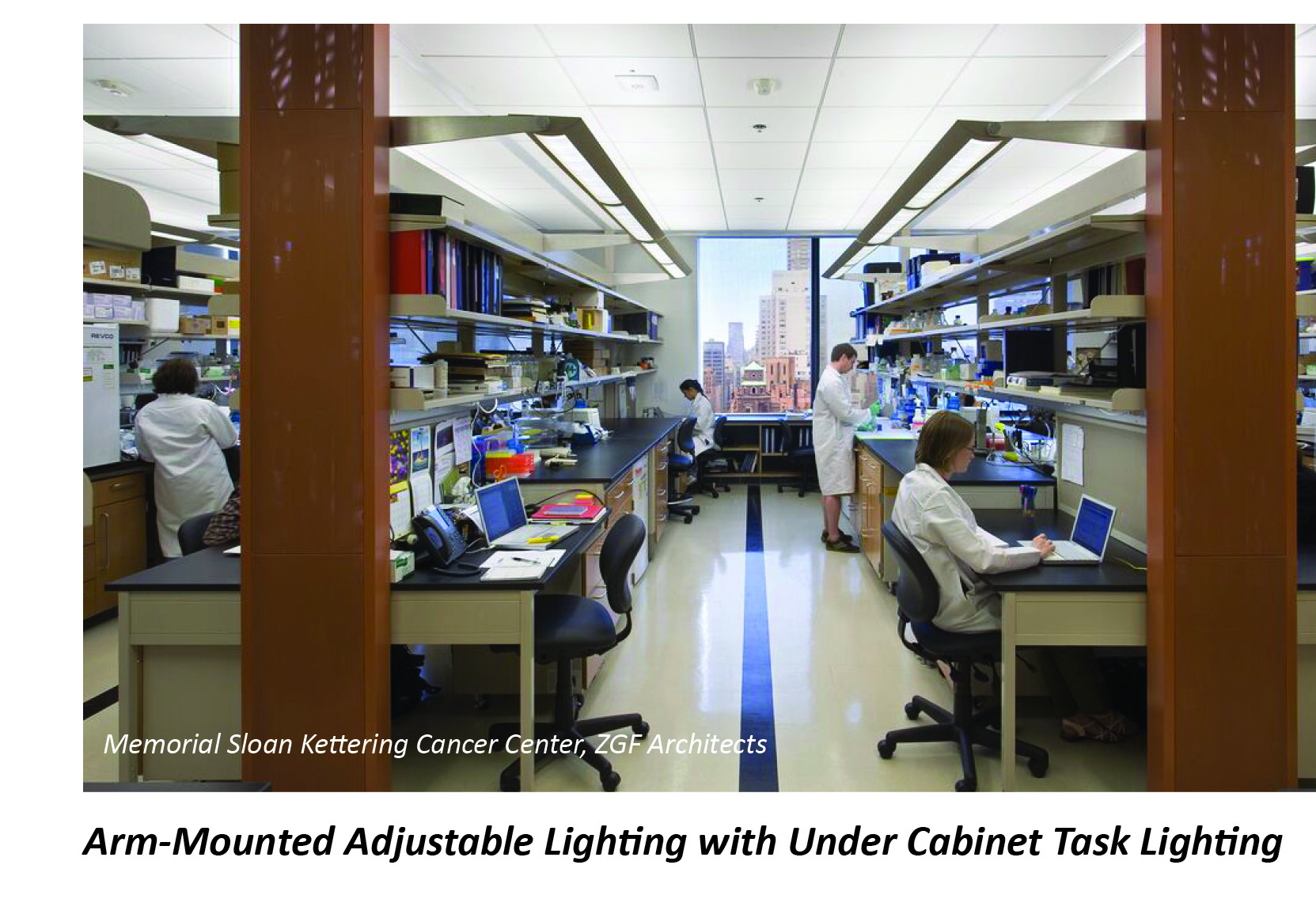 The two types of mounting systems (under-cabinet and arm-mounted adjustable) are the preferred systems to provide higher values of task illuminance on the work-plane. Under-cabinet lighting with vacancy sensors is the best approach to perform tasks at eye level, however, it may limit the type of chemicals stored on the shelf due to heat generated from the luminaire. Arm-mounted adjustable task lighting creates flexibility and maximizes visibility. Understanding the purpose of the space will help you select the best system for your project.
The two types of mounting systems (under-cabinet and arm-mounted adjustable) are the preferred systems to provide higher values of task illuminance on the work-plane. Under-cabinet lighting with vacancy sensors is the best approach to perform tasks at eye level, however, it may limit the type of chemicals stored on the shelf due to heat generated from the luminaire. Arm-mounted adjustable task lighting creates flexibility and maximizes visibility. Understanding the purpose of the space will help you select the best system for your project.
Task lighting contributes to energy saving in three ways. First, we can locate the light source close to the work-surface. In this way, the light is used efficiently to produce the illumination levels needed for a particular task. Second, the base illumination level in the lab can be lowered while all critical areas receive illumination from the task light. And third, task lighting gives flexibility to the users to control their own environment. It is important to make sure that task lighting with vacancy sensors and dimmers is integrated into the design early in the process because energy efficiency is achieved by reducing ambient light levels and ensuring that the task lights are turned off when not needed. A vacancy sensor device will help detect when a space is unoccupied and will adjust accordingly, ultimately saving energy.
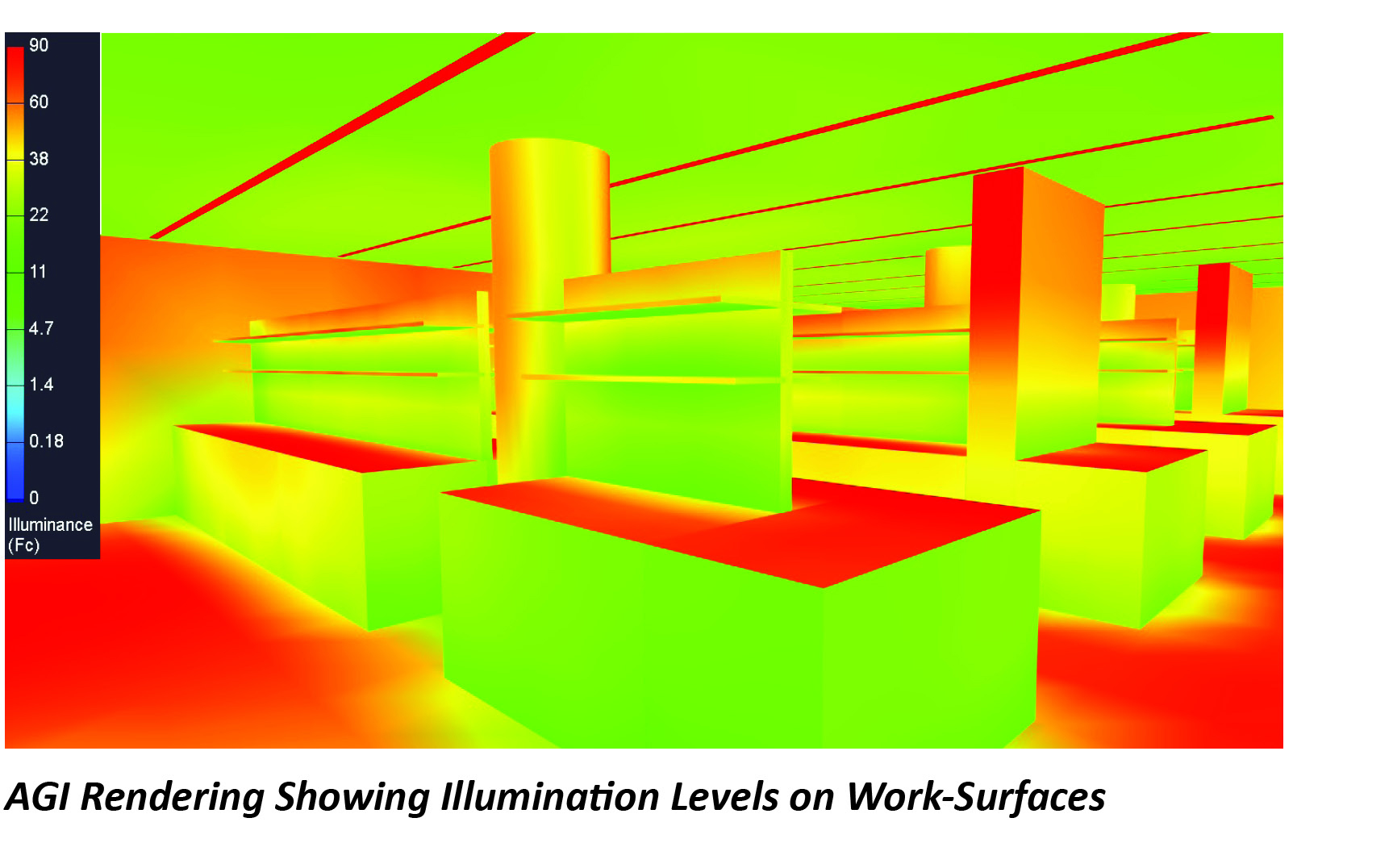 The goal of a well-designed lighting approach is to provide the required illumination levels for researchers and employees to be able to perform their tasks. Recommended lighting levels vary for different types of lab spaces. A common challenge is designing around the many obstructions in these spaces, including tall shelves and large equipment on lab benches. Providing uniform illumination on both working and vertical surfaces is important to avoid high contrast lighting reducing eyestrain and visual fatigue.
The goal of a well-designed lighting approach is to provide the required illumination levels for researchers and employees to be able to perform their tasks. Recommended lighting levels vary for different types of lab spaces. A common challenge is designing around the many obstructions in these spaces, including tall shelves and large equipment on lab benches. Providing uniform illumination on both working and vertical surfaces is important to avoid high contrast lighting reducing eyestrain and visual fatigue.
Since most labs require high light levels, the width of the fixture aperture and optics are the most important consideration for visual comfort and glare reduction. This also helps meet requirements for luminance value of less than 6,000 cd/m2 or UGR 16 to qualify for LEED and WELL certification.
The most common and preferred option for lab spaces is to choose a correlated color temperature (CCT) that ranges from 3500K - 5000K instead of warmer color temperature. The higher color temperatures blend naturally with daylight and maintain alertness during work hours. It is important to keep the CCT consistent throughout the space, including task lighting. A high color rendering index (CRI) value is required for better color rendering in laboratories with 90+ as the standard for all general and task lighting.

In a 24-hour cycle, there is a need to plan lighting for groups that work day vs. night shifts. Night shift employees are required to work when they are biologically programmed to sleep. Since labs are highly dependent on shifts, it is important to consider the safety and health of these employees. Lighting is one of the most fundamental aspects since it affects work performance, mental state, circadian regulation and long-term health. With the advancement in lighting technology, electric light now has the opportunity to provide daylight stimulus through advanced lighting techniques.
The design scheme has been made, correct lighting has been chosen and locations have been set. Now what? By creating a thoughtfully designed and commissioned lighting control system all your hard work can operate together to support productivity, occupant wellness and contribute to energy savings.
Lighting controls are typically a mandatory requirement and include several provisions. Automatic control systems are ideal for energy savings but often lack personalized control and flexibility. Local controls that are switches and dimmers are required in all enclosed spaces so occupants can adjust the lighting in different levels. Continuous dimming systems for electric lighting allow for gradual increase and decrease in light intensity and are more satisfactory and pleasant for visual comfort.
 Whatever system you choose, automatic vs personalized, a Sequence of Operation is needed to create a completely successful life sciences project. This important component often gets overlooked since it technically doesn’t belong to anyone’s general scope of work. Creating a sequence of operation that considers daylight harvesting, time clock lighting controls and preferred operation times will create more productive spaces that also save more energy.
Whatever system you choose, automatic vs personalized, a Sequence of Operation is needed to create a completely successful life sciences project. This important component often gets overlooked since it technically doesn’t belong to anyone’s general scope of work. Creating a sequence of operation that considers daylight harvesting, time clock lighting controls and preferred operation times will create more productive spaces that also save more energy.
For a printable version click here.